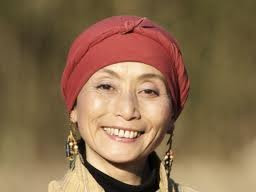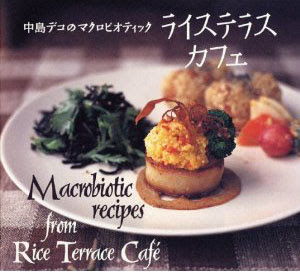::::::::::::::::::::::::::::::::::::::::::::::::::::::::::::::::::::::::::::::::::::::::::::::::::::
Deco Nakajima 中島デコ Nakajima Deko

Eco Farm Stay
Brown's Field gives you the chance to do just that. Tucked away in Chiba Prefecture's Boso Peninsula, Brown's Field consists of a traditional Japanese farmhouse, the Rice Terrace café (open at weekends), a yurt, a couple of rice fields and lots of ducks, goats and cats.
The farm was founded in 1999 by essayist and Macrobiotic cooking teacher Deco Nakajima and her husband, writer/photographer Everett Kennedy Brown.
source : www.insidejapantours.com

More of her books on natural cooking :
source : www.amazon.co.jp
:::::::::::::::::::::::::::::::::::::::::::::::::::::::::::::::::::::::::::::::::::::::::::::::::::::
quote
American photojournalist combines traditional with modern in daily life
Everett Brown's lifestyle is a reflection of his philosophy on life.
The American photojournalist, who has lived in Japan for 24 years, says that the Japanese people should re-create their traditions by fusing classical ideas with modern technologies or ideas to lead happy, comfortable lives.
"So many Japanese people are thinking just about the future, the future, the future. . . . I really feel that so much of the richness and the beauty and the strength of Japan is in the cultural heritage," said Brown.
The American photojournalist, who has lived in Japan for 24 years, says that the Japanese people should re-create their traditions by fusing classical ideas with modern technologies or ideas to lead happy, comfortable lives.
"So many Japanese people are thinking just about the future, the future, the future. . . . I really feel that so much of the richness and the beauty and the strength of Japan is in the cultural heritage," said Brown.
Incorporating modern elements into traditional ideas is the central theme of both his profession and his daily life.
Aside from his job as a photographer, he owns a farm called Brown's Field in Isumi, southeastern Chiba Prefecture, that comprises rice paddies, woods, a cafe serving food made from local organically grown products, a guest house converted from a Meiji-era barn and hand-crafted tree-houses. This year, he bought a large farmhouse and renovated it into a country inn named Jiji no Ie.
Brown, 53, of slight build and with long platinum hair, has for the past 10 years served as chief photographer at the Japan branch of the German-based European Pressphoto Agency. He plans to leave the company in November, however, to pursue personal projects.
"It's time for new challenges. It's time to focus on articulating stories that I feel I need to tell. My lifework is to explore and articulate the historical memories hidden in the Japanese landscape," he said.
While he has taken mostly news photos for EPA, his personal work is taking collodion (wet plate) photographs of people and landscapes using an antique camera that "dates from end of the Edo Period." Such a classical technology, he says, creates a "timeless" aspect to the photos he takes.
He bought the farmhouse partly because he and his wife wanted to create an "eco-village."
"When my wife and I first had a look at the house, it was like a calling — that we need to buy this house and make it into a country inn where people can enjoy the best of farm living," he said.
After purchasing the property, they found out that the farmhouse had previously served as a gathering place for villagers during the annual harvest festival.
"It was the role of this house to provide food and sake for the villagers," Brown said.
In recent years the festival was stopped due to lack of young people to carry the portable mikoshi (shrine). It is Brown's dream to eventually restore the village festival.
The inn and the Brown's Field farm now offer workshops and farming internships to let people experience sustainable, organic living based on traditional wisdom.
Brown's wife, Deco Nakajima,
a best-selling natural foods cookbook writer, specializes in a type of diet with a variety of fermented foods and home-grown products, such as genmai (unpolished rice), beans and vegetables. She offers cooking classes at Jiji no Ie.
Most of the rice and vegetables served at the inn are grown at Brown's Field.
"Growing rice is especially important in order to understand Japan," he said, "because until the Meiji Era, 90 percent of Japanese people were living agrarian lifestyles and much of the culture is based on agrarian sensibility.
"In order to more fully understand Japan, I felt that I needed to be able to grow my own rice, make my own miso, to more deeply experience the changes in the seasons. Farming is a way for me to understand the Japanese sensitivity toward nature and to become aware of the subtle changes in the seasons," he said, adding that he finds it very interesting how the seasons "are very subtly overlapped" in Japan.
"In the middle of winter, you have the plum blossoms. You are already getting a hint of spring. This is where Japanese aesthetics were born — in this overlapping of the seasons," he said.
Brown uses the term "shibu-modern" to explain the theme in his lifestyle and his design for his country inn.
"Shibu-modern is a way of integrating traditional aspects of living with modern technology and design to provide a deeply rich Japanese aesthetic experience. Shibui means traditional, rustic atmosphere. Shibu-modern is not just old and rustic, but it the aesthetic merging with modern design elements," said Brown.
Several examples of shibu-modern can be seen at Jiji no Ie. One example is the suikinkutsu — an underground ceramic urn in the inn's Japanese garden that makes a beautiful sound when water drips into it.
Brown said he wanted to re-create the aesthetic of an Edo Period tea house garden. He asked Yosuke Yamaguchi, an award-winning gardener from Nagasaki, to design the garden, to build the suikinkutsu as an aesthetic feature in the inn's garden.
Suikinkutsu became nearly forgotten after the Edo Period as their chambers got clogged with fallen leaves. "By using modern hydraulic technology, we can now flush the leaves clear," he explained.
Brown and his wife moved to Isumi from Tokyo's Setagaya Ward in 1999 with their five children, because they wanted enough space for their children to play and to grow up in a healthy environment.
"A friend said a house was available in Chiba. When we saw it, we just fell in love with it," he said, adding that originally, they weren't thinking of opening an inn at all.
However, they started having friends come over for tea, and then stay overnight, so they thought, "Why not create a cafe and inn where more people can enjoy this great traditional farm lifestyle?"
Brown said that in France and Italy, there are traditional farmhouses where people can stay and experience rural life, and he felt there was "a need for such inns in Japan, too," he said.
Brown was born in Washington, D.C., to parents of Welsh and Scottish descent. His father was a well-read Presbyterian minister. The family moved to North Carolina when Brown was 3, and then to Missouri.
Brown started taking photographs at age 11. Having met and being inspired by the famed photographer William Eugene Smith, who is known for his photographs from the early 1970s depicting victims of Minamata disease in Japan, he decided to become a photojournalist when he was 13. He started taking photographs professionally the following year, starting out with wedding photos and portraits, and then taking on photographic work for publishing companies.
While studying anthropology at a U.S. university, Brown went to study Buddhism in India as part of his course work for half a year, and traveled to 50 countries while still in his 20s.
He said India was where he initially encountered Japanese aesthetic sensibility. He went to a Zen temple in northern India's Bodh Gaya — a place where Buddha is said to have obtained enlightenment — and sat zazen on New Year's Day.
"By sitting, I found that I was able to see the world with much clearer eyes, and things had more detail, everything had more of an aesthetic quality. I felt that this sensitivity was very, very useful for my photography," he said, adding that he decided to go to Japan after he graduated from university — also because he was studying oriental medicine and wanted to study acupuncture in Japan.
Brown says his family had old ties with Japan. Eliphalet Brown (1816-1886) — his distant ancestor — came to Japan as a photographer for Commodore Matthew Perry of the U.S. Navy, when Perry came to open Japan on a black-hulled frigate in 1853.
Brown's father and uncle also traveled to Japan while serving in the U.S. Navy. "My house and my grandmother's house were full of Japanese pottery, lacquerware and carvings," Brown said.
"Life is just a continuous, unfolding journey," Brown said with a serene smile.
"There's always this feeling of achieving completeness, and then the journey begins again, and there are other areas of myself to explore. In terms of photography, in the past few years, my personal vision has come together in the collodion photographic process. It's taken a long time to integrate all the different experiences in my life into a distinct style and philosophy."
For information on Brown's Field and Jiji no Ie :
www.brownsfield-jp.com and
jijinoie.com.
source : Japan Times, August 2012
*****************************
Related words
***** . WKD : Main Index .
. WASHOKU - GENERAL INFORMATION .
:::::::::::::::::::::::::::::::::::::::::::::::::::::::::::::::::::::::::::::::::::::::::::::::::::




No comments:
Post a Comment